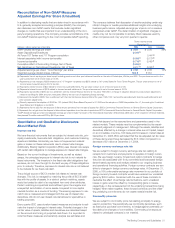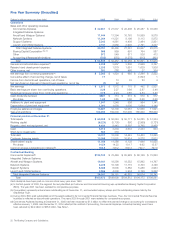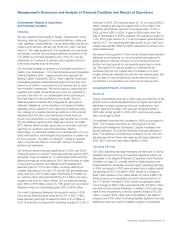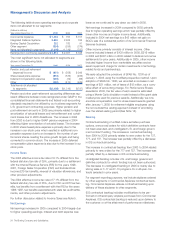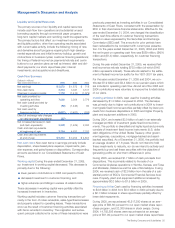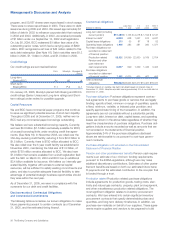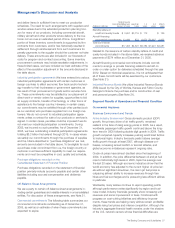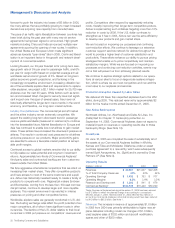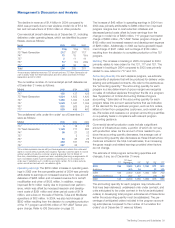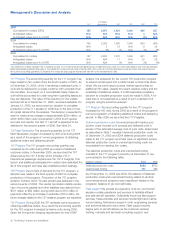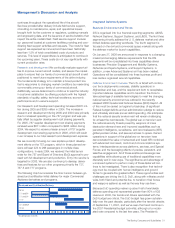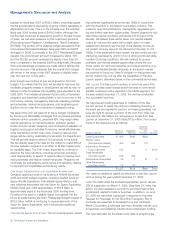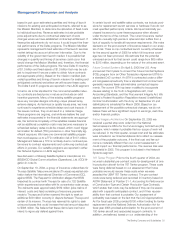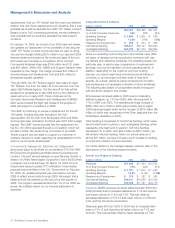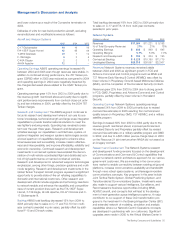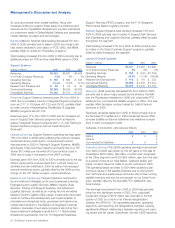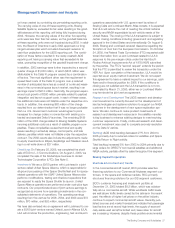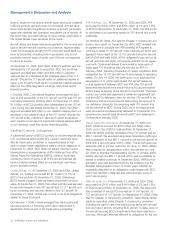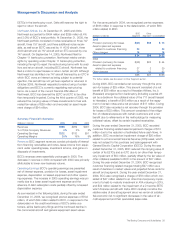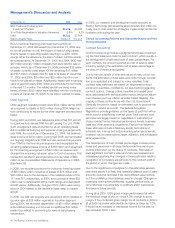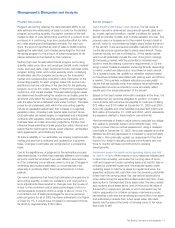Boeing 2005 Annual Report Download - page 33
Download and view the complete annual report
Please find page 33 of the 2005 Boeing annual report below. You can navigate through the pages in the report by either clicking on the pages listed below, or by using the keyword search tool below to find specific information within the annual report.
Management’s Discussion and Analysis
continues throughout the operational life of the aircraft.
Services provided after delivery include field service support,
consulting on maintenance, repair, and operational issues
brought forth by the customer or regulators, updating manuals
and engineering data, and the issuance of service bulletins that
impact the entire model’s fleet. Field service support involves
our personnel located at customer facilities providing and coor-
dinating fleet support activities and requests. The costs for fleet
support are expensed as incurred and have been historically
less than 1.5% of total consolidated costs of products and
services. This level of expenditures is anticipated to continue in
the upcoming years. These costs do not vary significantly with
current production rates.
Research and development We continually evaluate opportuni-
ties to improve current aircraft models, and assess the market-
place to ensure that our family of commercial jet aircraft is well
positioned to meet future requirements of the airline industry.
The fundamental strategy is to maintain a broad product line
that is responsive to changing market conditions by maximizing
commonality among our family of commercial aircraft.
Additionally, we are determined to continue to lead the industry
in customer satisfaction by offering products with the highest
standards of quality, safety, technical excellence, economic
performance and in-service support.
Our Research and Development spending increased $361 mil-
lion during 2005 and $265 million in 2004. The increase in
research and development during 2005 and 2004 was primarily
due to increased spending on the 787 program and was par-
tially offset by supplier development cost sharing payments.
For 2005, 787 supplier development cost sharing payments
received were $611 million compared to $205 million during
2004. We expect to receive a lesser amount of 787 supplier
development cost sharing payments in 2006, which will result
in an increase to our total research and development expense.
We are currently focusing our new airplane product develop-
ment efforts on the 787 program, which in three planned ver-
sions will seat 223 to 296 passengers in multiple class
configurations. In early 2004, we received the initial launch
order for the 787 and Board of Directors (BoD) approval to pro-
ceed with full development and production. Entry into service is
targeted for 2008. We are also continuing to develop deriva-
tives and features for our other programs primarily the 737,
747-8 and 777 programs.
The following chart summarizes the time horizon between go-
ahead and certification/initial delivery for major Commercial
Airplanes derivatives and programs.
00 01 02 03 04 05 06 07 08 09
787-8
777-300ER*
777-200LR*
777-F
747-400BCF
747-8
Go-ahead and Certification/Delivery
Integrated Defense Systems
Business Environment and Trends
IDS is organized into four financial reporting segments: A&WS,
Network Systems, Support Systems, and L&OS. The first three
segments primarily address the U. S. defense market and other
limited defense spending worldwide. The fourth segment is
focused on the civil and commercial space markets along with
the defense market for launch capabilities.
On January 27, 2006 we announced in response to a changing
market and emerging defense requirements that the IDS
segments will be consolidated into three capabilities-driven
businesses: Precision Engagement and Mobility Systems,
Networks and Space Systems, and Support Systems. In
addition, a new Advanced Systems unit has been created.
Operations will be consolidated into three business profit and
loss centers organized around capabilities.
Defense Environment Overview The U.S. is faced with continu-
ous force deployments overseas, stability operations in
Afghanistan and Iraq, and the requirement both to recapitalize
important defense capabilities and to transform the force to
take advantage of available technologies to meet the changing
national security environment as outlined in the recently
released 2006 Quadrennial Defense Review (QDR) Report. All
of this must be carried out against a backdrop of significant
Federal budget deficits and an administration pledge to reduce
and ultimately eliminate annual deficit spending. We anticipate
that the national security environment will remain challenging
for at least the next decade. The global war on terrorism and
the national security threats posed by weapons of mass
destruction demand new and improved capabilities such as
persistent intelligence, surveillance, and reconnaissance (ISR),
global precision strike, and assured access to space. Recent
operations in support of the global war on terrorism have
demonstrated the value of networked and fused ISR combined
with advanced command, control and communications sys-
tems; interdependence across platforms, services, and Special
Forces; and the leveraging effects of precise, persistent, and
selective engagement. All of these enable and leverage new
capabilities while allowing use of traditional capabilities more
discretely and in new ways. The significance and advantage of
unmanned systems to perform many of these tasks will con-
tinue to be investigated. There is also recognition that technol-
ogy must be coupled with human intelligence and ground
forces to generate the greatest effect. These opportunities and
challenges are driving the U.S. DoD, along with militaries world-
wide, both friend and potential foe, to transform their forces
and weapons systems as well as the way they use them.
Because DoD spending makes up about half of worldwide
defense spending and represented greater than 90% of IDS
revenue in 2005, the trends and drivers associated with the
DoD budget are critical. The DoD budget has grown substan-
tially over the past decade, particularly after the terrorist attacks
of September 11, 2001, and we’ve seen that trend continue in
the 2007 Presidential budget submittal, although at a moder-
ated rate compared to the last few years. The President’s
*Go-ahead prior to 2003.
The Boeing Company and Subsidiaries 31


